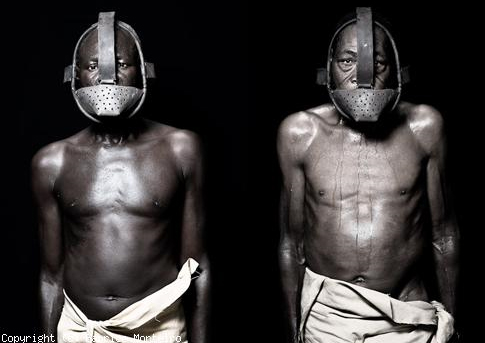"Marrons. Les esclaves fugitifs" (Brown Runaway Fugitive Slaves) photographed by Fabrice Monteiro
"Brown. Fugitive Slave," is an article published in his newsletter Africultures is an evocation of runaways through the eyes of Fabrice Monteiro. An article that is timely to commemorate the 163 th anniversary of the abolition of slavery in Guadeloupe, 27 May 2011 .
"Marrons. Les esclaves fugitifs" (Brown Runaway Fugitive Slaves) photographed by Fabrice Monteiro
"Maroon" is a term borrowed from the Spanish "cimarron," meaning "living on the peaks."
It comes from a word "Arawak" defining domestic animals returned to the wild, and by extension, runaway slaves. The "Maroon" was a terrible threat to the colonial system, they were likely to provoke a civil war at any time. Fugitive slaves were monitored continuously and the sentences at the slightest deviation were particularly severe, they had to make an impression.
"Marrons. Les esclaves fugitifs" (Brown Runaway Fugitive Slaves) photographed by Fabrice Monteiro
Slaves who tried to escape suffering the punishment described by the law then they were made to wear a heavy iron necklace with long stems, which had the function to hang in the brush and hamper any escape. In the same spirit, they existed in shackles bells, can hear every movement of the slave. The slave who dared to speak a bit to his master suffered the punishment of the Iron Mask. Similarly, during the harvest of sugarcane, were put in iron masks to hungry and thirsty slaves to prevent them from tasting or eating the cane.
"Marrons. Les esclaves fugitifs" (Brown Runaway Fugitive Slaves) photographed by Fabrice Monteiro
During childhood in Benin, Fabrice Monteiro is marked by the cartoon "The Passengers of the Wind" of Bud Francis. Part of the adventure takes place in Ouidah, Benin, home village of his father's family. He is fascinated by the realism of images, it recognizes the scene drawn, the faces are familiar to him. It is in these pages he discovered these strange necklaces worn by some slaves to keep them from escaping. His father tells him the story of his family and why he wears a name like many other Portuguese Benin. His ancestor was named Ayedabo Adagoun Odo, his native Nigeria. He is enslaved by the Portuguese and sent to Brazil. He returned to Benin years later, freed by the name of Pedro Monteiro.
"Marrons. Les esclaves fugitifs" (Brown Runaway Fugitive Slaves) photographed by Fabrice Monteiro
Sensitive to the issue of the slave trade and the role of this small village on the coast of Benin, Fabrice decides to explore the subject photographically to contribute to the memory of slavery. From the * CODE BLACK, lithographs and of the few original photos of slaves, Fabrice plans reconstructs five models of barriers used to punish or deter the slaves of their escape. It is from these plans that two young blacksmiths Benin reproduce barriers staged in this photographic series. To obtain an effect of chiaroscuro, he chose a modern approach to treatment of light. He designed a black box, allowing a mobile studio to meet its models through the streets of Ouidah.
"Marrons. Les esclaves fugitifs" (Brown Runaway Fugitive Slaves) photographed by Fabrice Monteiro
* The BLACK CODE was developed by the French minister Jean-Baptiste Colbert (1616 - 1683) and promulgated in March 1685 by Louis XIV. [source: Fabrice Monteiro ( Article published by Africultures on 05/05/2011)]
"Marrons. Les esclaves fugitifs" (Runaway Fugitive Slaves) photographed by Fabrice Monteiro
"Marrons. Les esclaves fugitifs" (Runaway Fugitive Slaves) photographed by Fabrice Monteiro
"Marrons. Les esclaves fugitifs" (Runaway Fugitive Slaves) photographed by Fabrice Monteiro
RON'S COMMENTS: Yes, these powerful images are disturbing. It reminds us that human beings sit at the forefront of ALL enslavement. The state-sponsored institutionalization of human trafficking and bondage for profit involves human beings. Millions upon millions of nameless, faceless people who toiled for the enrichment of plutocrats, merchants, kings, queens, aristocrats, planters, shipbuilders, bankers, insurance brokers, shareholders and the like. They were never paid, never thanked, even after emancipation never made whole. I honor their spirit of survival.
This small blog tries to offer a space to historically discuss and make sense of their inhuman bondage.





How can I obtain permission to use some of the images here. They speak very loudly
ReplyDelete